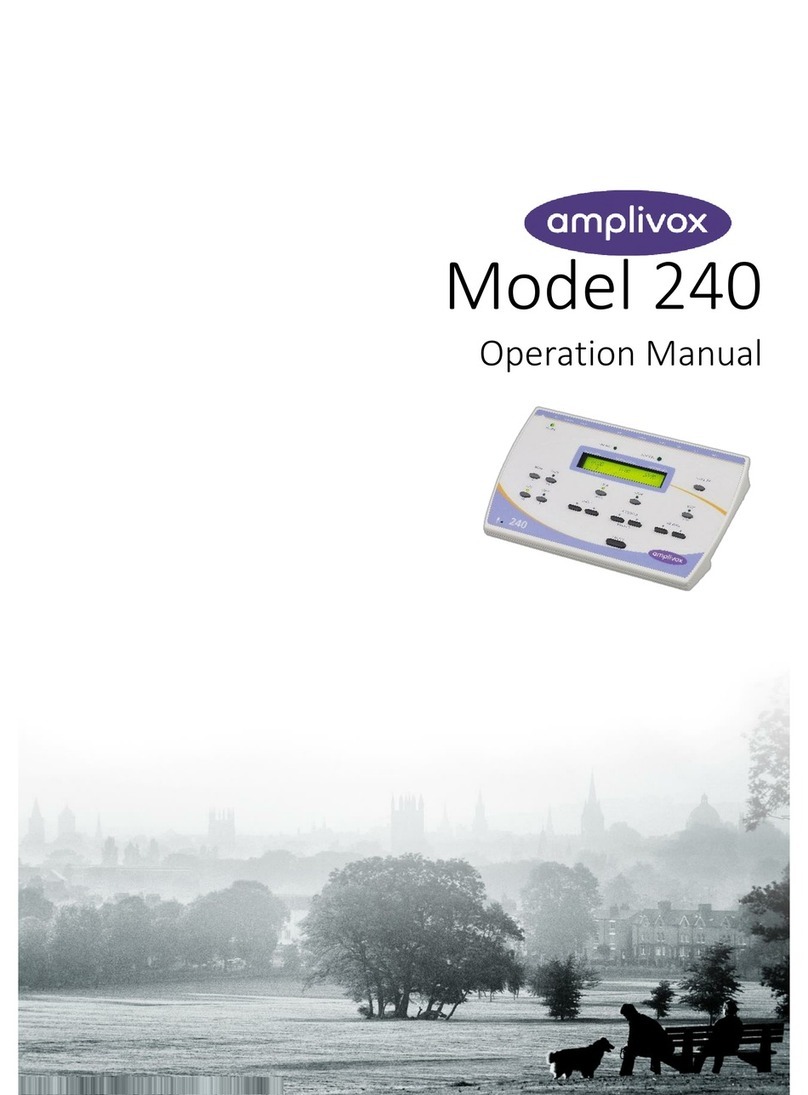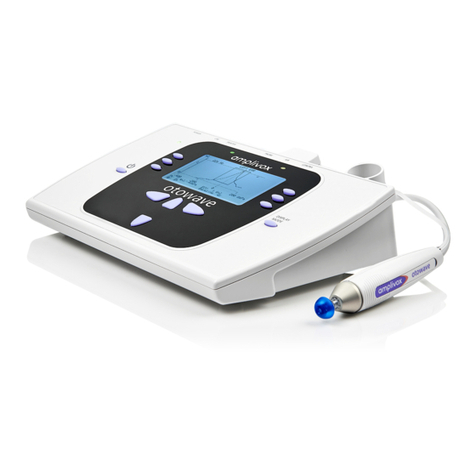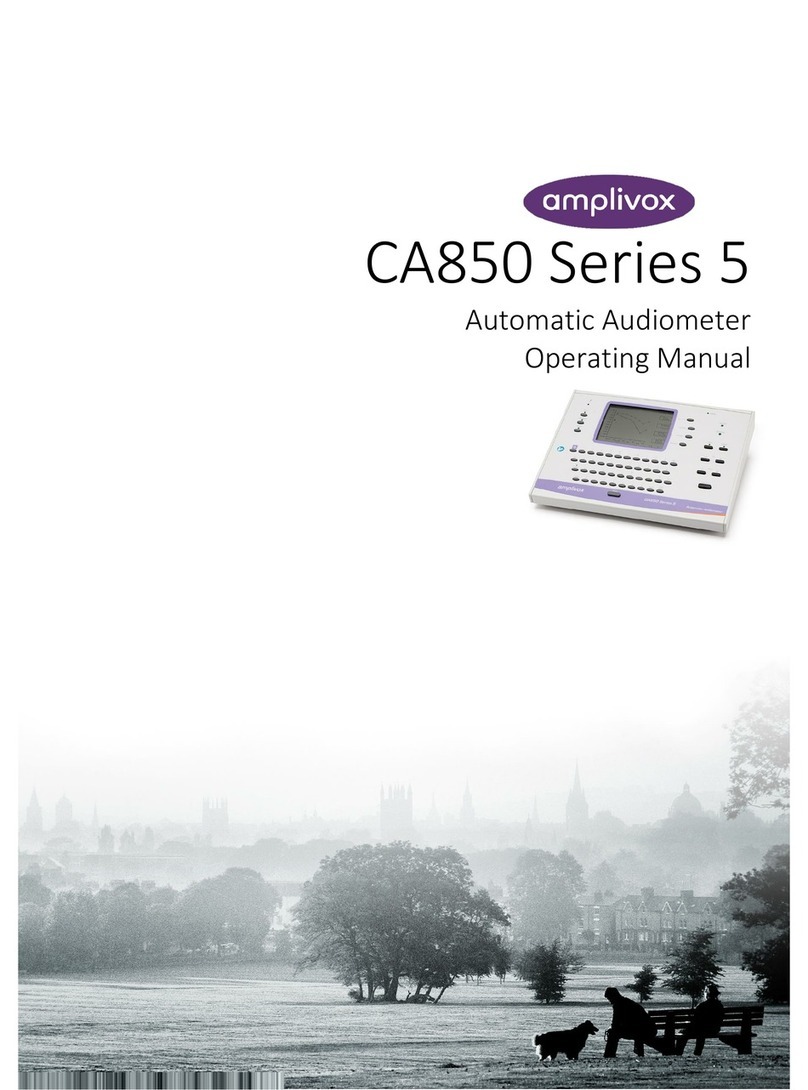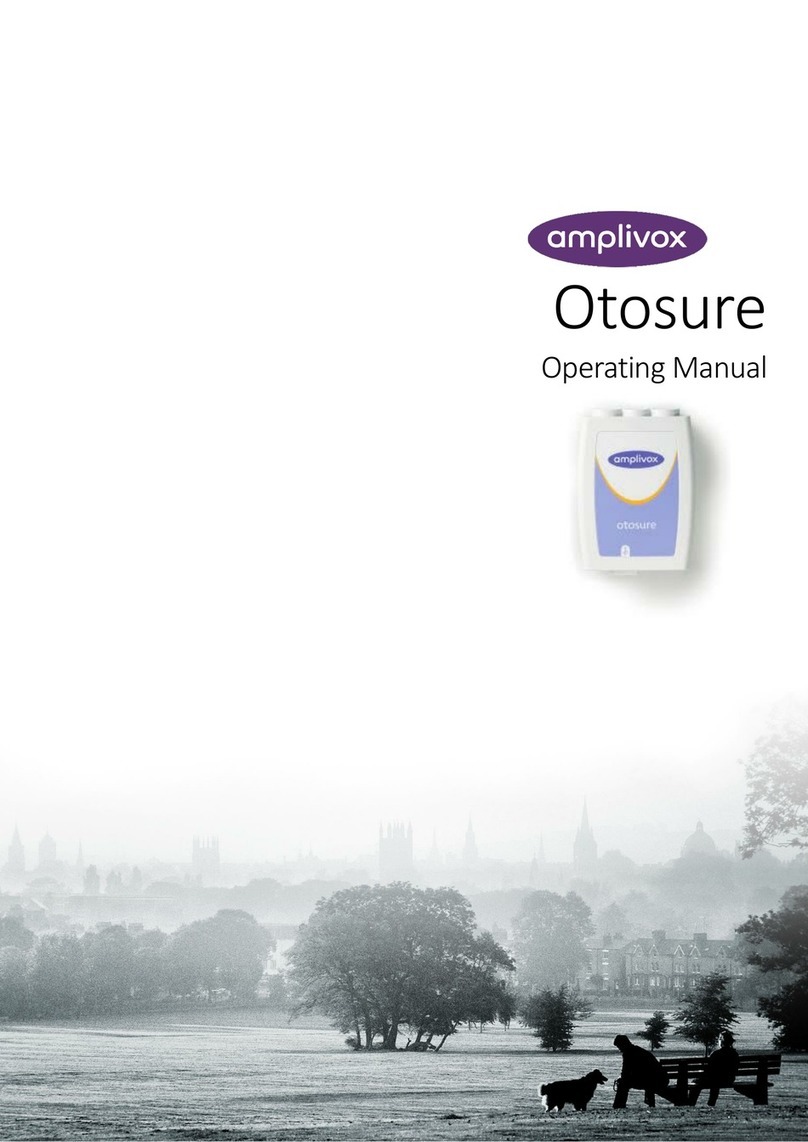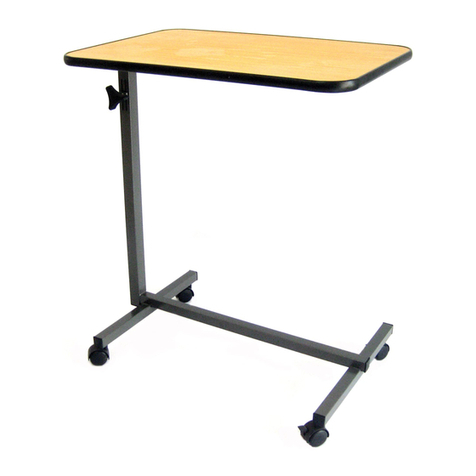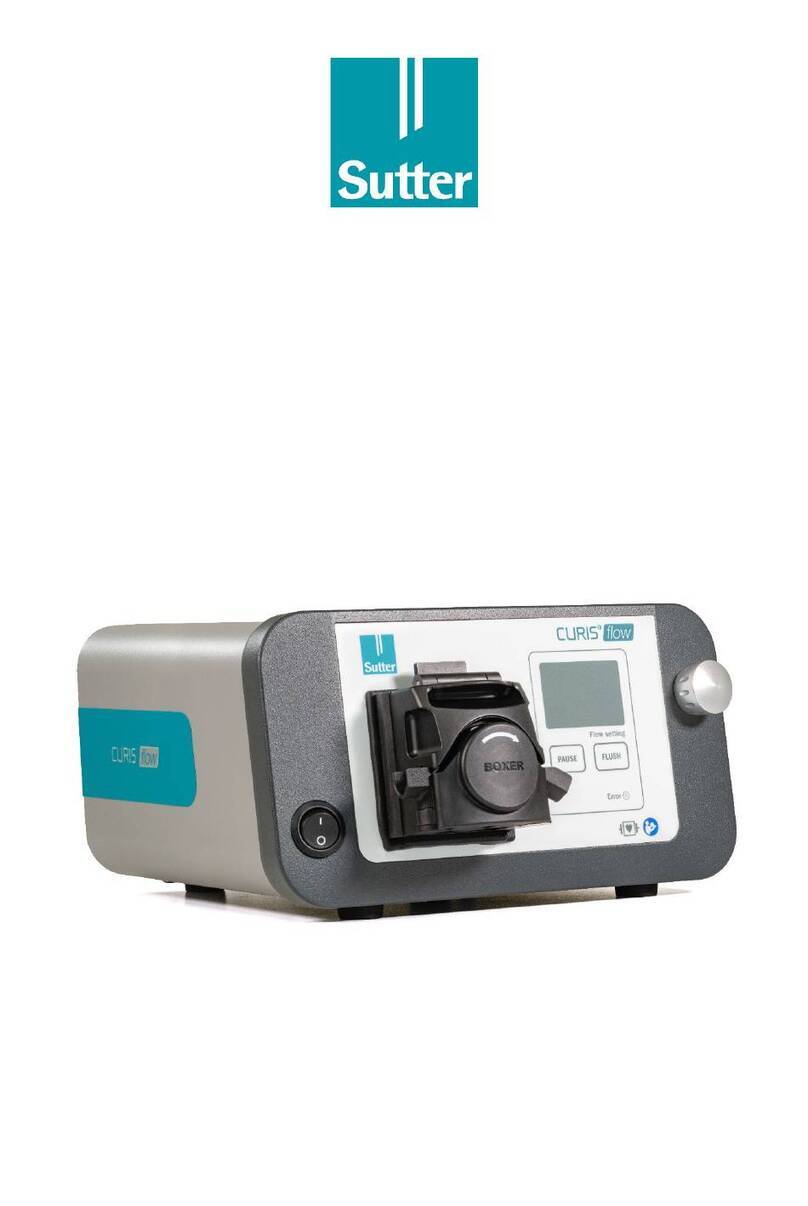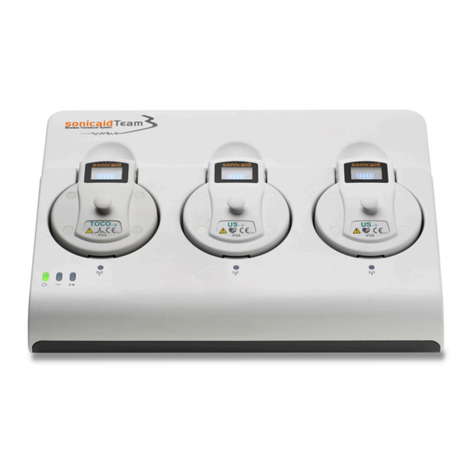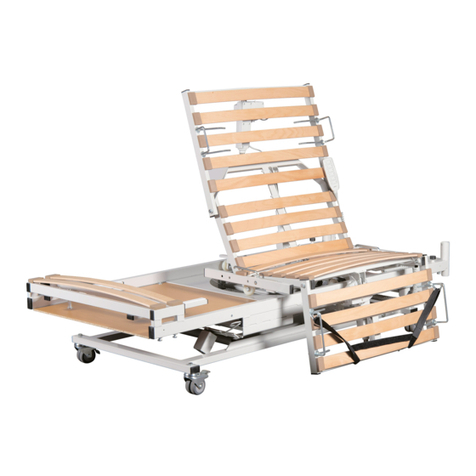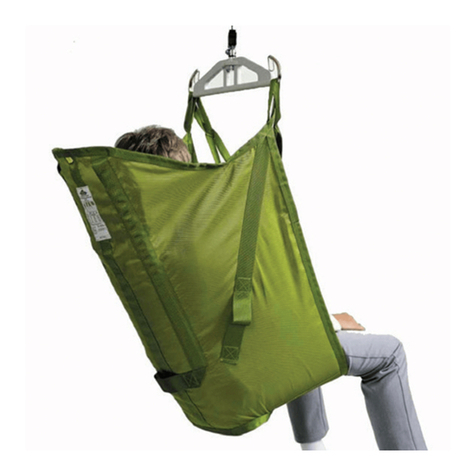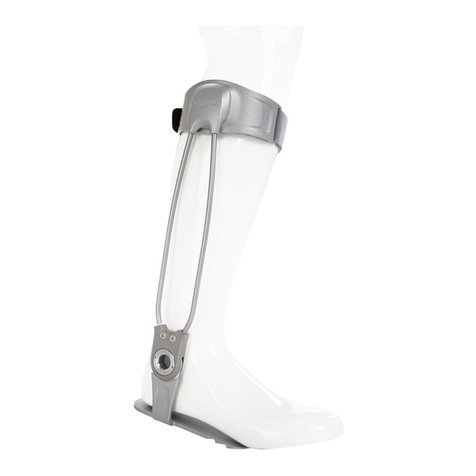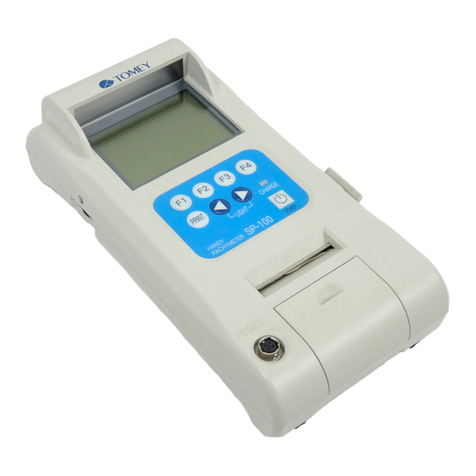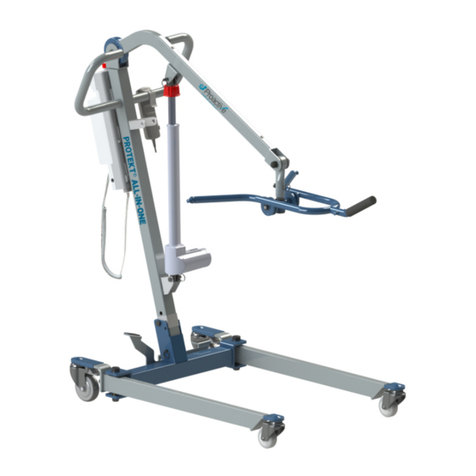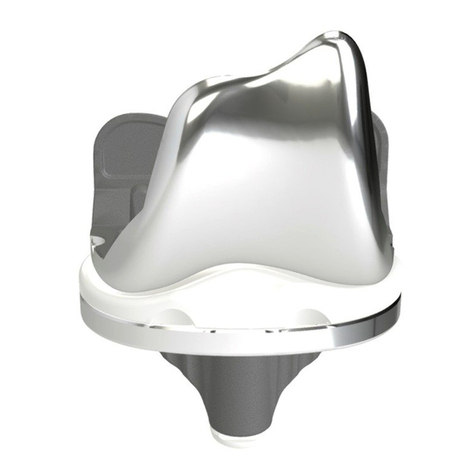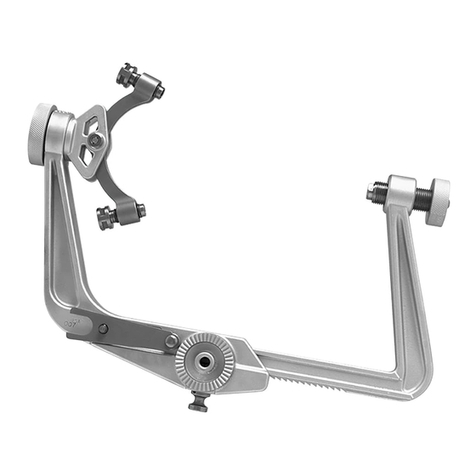AmpliVox Otowave 102-C User manual

Otowave 102-C
Operating Manual

ABOUT THIS MANUAL
READ THIS OPERATING MANUAL BEFORE ATTEMPTING TO USE THE INSTRUMENT.
This manual is valid for the Otowave 102-C (applies from firmware version 1.0.0.084600 onwards –see System
Information screen).
This product is manufactured by:
Amplivox Ltd.
3800 Parkside, Solihull Parkway,
Birmingham Business Park,
Birmingham, West Midlands,
B37 7YG
United Kingdom
www.amplivox.com
For all enquiries please contact us:
Amplivox Ltd.
10393 West 70th Street
Eden Prairie
MN 55344
United States
Tel: 888 941 4208
Fax: 952 903 4100
Amplivox Ltd.
3800 Parkside, Solihull Parkway,
Birmingham Business Park,
Birmingham, West Midlands,
B37 7YG
United Kingdom
Tel: +44 (0)1865 880846

If supplied in the US, please note:
Caution: Federal Law restricts this device to sale by or on the order of a licenced medical professional.

i
D-0014930xxxxxxx-A –Otowave 102-C Operating Manual
TABLE OF CONTENTS
1. Introduction..........................................................................................................................................................1
1.1. Thank you .....................................................................................................................................................................1
1.2. Intended applications...................................................................................................................................................1
1.3. Features........................................................................................................................................................................1
1.4. Unpacking.....................................................................................................................................................................1
1.5. Standard contents and optional accessories................................................................................................................1
1.6. Guarantee.....................................................................................................................................................................2
1.7. Warnings.......................................................................................................................................................................2
2. Important Safety Instructions ...............................................................................................................................3
2.1. Precautions...................................................................................................................................................................3
2.2. Electromagnetic compatibility (EMC) considerations ..................................................................................................3
3. Principles of Operation .........................................................................................................................................4
3.1. Otoscopic examination.................................................................................................................................................4
3.2. Principals of Admittance measurement .......................................................................................................................4
3.3. Tympanogram...............................................................................................................................................................4
3.4. Acoustic reflex measurement.......................................................................................................................................4
4. Using the Otowave................................................................................................................................................6
4.1. Battery-PACK ................................................................................................................................................................6
4.2. Operating language ......................................................................................................................................................6
4.3. The Cradle.....................................................................................................................................................................6
4.3.1. General ......................................................................................................................................................................6
4.3.2. Connectors.................................................................................................................................................................6
4.3.3. Indicators...................................................................................................................................................................7
4.4. Controls and indicators Handheld Unit ........................................................................................................................8
4.5. The probe .....................................................................................................................................................................9
4.6. Start-up and menu displays..........................................................................................................................................9
4.7. Initial settings .............................................................................................................................................................10
5. Taking measurements.........................................................................................................................................11
5.1. Prior to testing and Ambient conditions ....................................................................................................................11
5.2. Ear tip(s)......................................................................................................................................................................11
5.3. Performing a test........................................................................................................................................................11
5.4. Ear seal check .............................................................................................................................................................14
5.5. Error messages ...........................................................................................................................................................15
6. Configuration......................................................................................................................................................16
6.1. Sweep Settings ...........................................................................................................................................................16
6.2. Reflex options.............................................................................................................................................................16
6.3. System Settings...........................................................................................................................................................17
7. Saving Results in the Internal Database ..............................................................................................................19
7.1. Data entry...................................................................................................................................................................19
7.2. Database full...............................................................................................................................................................19
8. Communication...................................................................................................................................................20
9. Transferring the Results ......................................................................................................................................21
9.1. Sending the results to a printer..................................................................................................................................21
9.2. Data transfer to NOAH or ampliSuite .........................................................................................................................21
10. Data Management ..............................................................................................................................................22

ii
D-0014930–A -Otowave 102-C Operating Manual
10.1. List records .................................................................................................................................................................22
10.2. Delete records ............................................................................................................................................................23
10.3. Print records ...............................................................................................................................................................23
11. Performing Daily Checks .....................................................................................................................................24
12. System Information ............................................................................................................................................25
13. Routine Maintenance .........................................................................................................................................26
13.1. Cleaning the Otowave ................................................................................................................................................26
13.2. Ear tip and Probe........................................................................................................................................................26
13.3. Calibration and Repair of the Instrument...................................................................................................................26
14. Error Messages & Fault Conditions .....................................................................................................................27
15. Technical Specification........................................................................................................................................29
15.1. Performance ...............................................................................................................................................................29
15.2. Equipment classification.............................................................................................................................................30
15.3. Symbols.......................................................................................................................................................................31
16. Disposal Information...........................................................................................................................................32
17. EMC Guidance & Manufacturer’s Declaration .....................................................................................................33
18. Use with Non-medical Electrical Equipment........................................................................................................37

INTRODUCTION
1
D-0014930-A –Otowave 102-C Operating Manual
1.INTRODUCTION
1.1.THANK YOU
Thank you for purchasing an Amplivox Otowave 102-C, a hand-held, portable tympanometer that will give
many years of reliable service if treated with care.
1.2.INTENDED APPLICATIONS
The Otowave 102-C is designed for use by audiologists, general practitioners, hearing aid dispensers and
child health professionals.
The instrument performs two types of measurement:
Tympanometry is used to measure the compliance of the tympanic membrane and middle ear at a fixed
frequency over a range of pressures.
Reflex tests are used to measure stapedial reflexes. The Otowave measures ipsilateral reflexes and, when
selected, reflex measurement is automatically carried out after a tympanogram is taken.
1.3.FEATURES
•Automatic measurement of ear canal volume, tympanic compliance peak, placement of the peak and
the gradient
•Automatic detection of stapedial reflexes
•Up to 32, dual-ear patient tests can be stored in non-volatile memory
•Configurable settings for user preferences, held in non-volatile memory
•Printout of data to a printer.
•Data transfer to a computer via USB for storage viewing & printing using either the Amplivox
“ampliSuite” software or the NOAH application
•English, French, Spanish, Portugese, Italian or German operating languages (user-selectable)
1.4.UNPACKING
Please check the contents of the shipping carton against the delivery note to make sure that all items ordered
have been included. If anything is missing, please contact the distributor who supplied your instrument or
Amplivox if you purchased direct.
Please retain the original shipping carton and packaging to transport the tympanometer for annual calibration
or repair.
1.5.STANDARD CONTENTS AND OPTIONAL ACCESSORIES
STANDARD ACCESSORIES
Otowave 102-C Tympanometer
handset
8518500
Set of disposable ear-tips
8029344
Otowave 102-C Tympanometer
Cradle
8518501
4 in 1 cavity assembly
(0.2 ml/0.5 ml/2.0 ml/5.0 ml)
8011362
Amplivox 5V power supply
8512734
USB with software (ampliSuite and
NOAH impedance module) and
operating manuals
8517685
USB cable to PC
8011241
Calibration certificate
8011512
Carrying case
8501590

INTRODUCTION
2
D-0014930-A –Otowave 102-C Operating Manual
OPTIONAL ACCESSORIES
Additional sets of ear tips
8029344
Probe tip
80025921
Sanibel MPT-II thermal printer
(standard in US conf.)
8503007
Seal (in probe tip)
80020091
Thermal Printer paper for Sanibel
MPT-II (standard in US conf.)
8029305
Printer cable –Otowave to Sanibel
MPT-II (standard in US conf.)
8004419
Please note: If the thermal printer has been purchased it should be charged for a minimum of 15 hours
before being used. Refer to the printer instructions for further details.
ACCESSORIES TO REORDER
Ear tip Otowave 3-5mm, 25 pieces
8012963
Ear tip Otowave 4-7mm, 25 pieces
8012965
Ear tip Otowave 7mm, 25 pieces
8013001
Ear tip Otowave 8mm, 25 pieces
8013003
Ear tip Otowave 9mm, 25 pieces
8012969
Ear tip Otowave 10mm, 25 pieces
8012971
Ear tip Otowave 11mm, 25 pieces
8012973
Ear tip Otowave 12mm, 25 pieces
8012975
Ear tip Otowave 13mm, 25 pieces
8012977
Ear tip Otowave 14mm, 25 pieces
8012979
Ear tip Otowave 15mm, 25 pieces
8012981
Ear tip Otowave 19mm, 25 pieces
8012983
1.6.GUARANTEE
All Amplivox instruments are guaranteed against faulty materials and manufacture. The instrument will be
repaired free of charge for a period of two years from the date of dispatch if returned, carriage paid, to the
Amplivox service department. Return carriage is free of charge for customers in the UK and chargeable for
overseas customers.
The following exceptions apply:
•The pressure pump and transducers may go out of calibration due to rough
handling or impact (dropping)
•The lifetime of probe, probe seals and ear tips is dependent upon conditions
of use. These parts are only guaranteed against faulty materials or
manufacture.
1.7.WARNINGS
Throughout this manual, the following meanings of warnings and cautions apply:
The WARNING label identifies conditions or practices that may present danger
to the patient and/or user.
The CAUTION label identifies conditions or practices that could result in damage
to the equipment.
1
Applied part as according to IEC 60601-1
WARNING
WARNING
CAUTION

IMPORTANT SAFETY INSTRUCTIONS
3
D-0014930-A –Otowave 102-C Operating Manual
2.IMPORTANT SAFETY INSTRUCTIONS
The Otowave 102-C instrument must be used only by practitioners qualified to perform
tympanometric tests. It is intended for transient use as a screening and diagnostic tool;
however no surgical or medical procedure should be undertaken solely on the basis of
results obtained from the instrument.
2.1.PRECAUTIONS
READ THIS OPERATING MANUAL BEFORE ATTEMPTING TO USE THE INSTRUMENT
The tympanometer is for indoor use only and should be used only as described in this manual.
Refer to the precautions specified in Section Error! Reference source not found.4.1 regarding the use of
batteries.
Before the first use of the instrument each day, or if suspect or inconsistent results are apparent, the checks
specified in Section 11 must be carried out. If these do not give the results specified, the instrument must not
be used.
Never insert the probe into a patient’s ear canal without a suitable ear tip fitted to the probe.
Use only the recommended disposable ear tips . These are for single use only - that is, each ear tip is intended
to be used once only for a single ear for a single patient. Do not reuse ear tips as this will pose the risk of ear-
to-ear or patient-to-patient cross-infection.
Do not immerse the unit in any fluids. See Section 13 of this manual for the proper cleaning procedure for the
instrument and its accessories and the function of single-use parts.
Do not use the instrument in an oxygen-rich environment or in the presence of a flammable anaesthetic mixture
or other flammable agents.
Do not drop or otherwise impact this instrument. If the instrument is dropped or damaged, return it to the
manufacturer for repair and/or calibration. Do not use the instrument if any damage is suspected.
The instrument must be stored and used indoors within the specified temperature, pressure and humidity
ranges, see Section 15.
As with all instruments of this nature, the measurements taken will be influenced by significant changes in
altitude & pressure. The Otowave 102-C tympanometer must be re-calibrated at the intended operating
elevation if it is to be used at elevations greater than 1000m above mean sea level.
Do not attempt to open, modify or service the instrument. Return the instrument to the manufacturer or
distributor for all repair and servicing requirements. Opening the instrument will void the warranty.
2.2.ELECTROMAGNETIC COMPATIBILITY (EMC) CONSIDERATIONS
Medical electrical equipment needs special precautions regarding EMC and needs to be installed and put into
service according to the EMC information in Section 17. This provides guidance on the electromagnetic
environment in which to operate the instrument.
Portable and mobile radio-frequency (RF) communications equipment can affect medical electrical equipment.
The instrument should not be used adjacent to or stacked with other equipment; if this is unavoidable the
instrument should be observed to verify normal operation.
WARNING

PRINCIPLES OF OPERATION
4
D-0014930-A –Otowave 102-C Operating Manual
3.PRINCIPLES OF OPERATION
3.1.OTOSCOPIC EXAMINATION
A suitably-qualified health care professional should perform a thorough otoscopic examination to establish that
the condition of the ear is suitable for the test options selected and that no contraindications are present. The
latter would include obstruction of the external ear canal due to excessive wax and/or hairs, both of which
would need to be removed. This is required to ensure that the probe tone delivered by the probe are able to
reach the ear drum and are not reflected by cerumen or debris and thereby alter the test result.
3.2.PRINCIPALS OF ADMITTANCE MEASUREMENT
The Otowave 102-C measures the admittance of the tympanic membrane and middle ear by playing a
continuous tone into the ear canal at 226 Hz. The level of this tone is calibrated to give 85 dB SPL (226 Hz)
into a 2 ml cavity. The sound level this produces in the ear canal is measured using a microphone and the
admittance calculated from the result.
In line with normal audiometric practice admittance is displayed as an equivalent volume of air in ml (for 226
Hz). The residual ear canal volume between the probe and the tympanic membrane is always displayed in ml.
3.3.TYMPANOGRAM
Tympanometry is part of the objective impedance test and provides information about the middle ear mobility
and pressure in the middle ear system.
To record the tympanogram, the admittance is measured while the air
pressure in the ear canal is varied from +200 daPa to -400 daPa by means
of a small pump. The admittance peaks when the air pressure is the same
on both sides of the tympanic membrane. The change of admittance with
pressure is displayed graphically.
3.4.ACOUSTIC REFLEX MEASUREMENT
Using the same principle as in tympanometry measures, it is also possible to establish whether an acoustical
reflex is present. The acoustic reflex is caused by the contraction of the stapedial muscle as a response to
high-intensity stimulation of the ear. The acoustic reflex is also a natural protection of the inner ear from too
high sound pressure levels which can cause damage to the hearing organ.

PRINCIPLES OF OPERATION
5
D-0014930-A –Otowave 102-C Operating Manual
In acoustic reflex testing, the 226Hz tone is used to measure the admittance of the ear, while a short tone at a
different frequency is presented (the reflex stimulus). The level of this stimulus is increased in steps until the
stapedial muscles respond, causing the tympanic membrane to become stiffer, or a preset maximum level is
reached. When the change in admittance exceeds a predetermined threshold this constitutes a reflex and the
change in admittance at that level when the stimulus is applied is displayed as a plot against time.
The stapedial reflex is measured at the static ear canal pressure that produces the maximum membrane
admittance, so reflex measurements are taken after the tympanogram is measured when the peak admittance
pressure has been established.
The reflex stimulus is produced in the ear being measured.

USING THE OTOWAVE
6
D-0014930-A –Otowave 102-C Operating Manual
4.USING THE OTOWAVE
4.1. BATTERY-PACK
The Otowave 102-C is powered by a rechargeable, built-in Nickel-Metal Hydride (NiMH) battery-pack. The
battery is not intended to be changed by the user. The battery pack may explode or cause burns, if
disassembled, crushed or exposed to fire or high temperatures. Do not short-circuit.
A battery state indicator is shown in the top right corner of the display (except when showing test results).
This shows the battery state as a progressively emptying battery. The 102-C should always be placed on its
cradle when not in use to allow the battery to trickle charge. When the symbol “!” appears next to the battery
state indicator, or when advised at switch-on the handset must be placed on its cradle to charge before further
use.
Depleated batteries do not affect the instrument configuration, the contents of the database, the calibration
settings or the results of the last test.
4.2.OPERATING LANGUAGE
To set the operating language (English, French,Spanish, Italian, Portugese or German) use the options within
the CONFIGURATION menu.
4.3.THE CRADLE
4.3.1. GENERAL
The Otowave 102-C is powered by a rechargeable Nickel-Metal Hydride (NiMH) battery-pack which is fitted in
the instrument. If the instrument is placed onto its cradle the battery will trickle chage.
4.3.2. CONNECTORS
The mains adapter is supplied as part of the equipment. Connect the output lead from the adapter into the
power socket in the rear of the instrument cradle. Switch on the mains supply. The mains adapter is the mains
disconnect device and therefore the tympanometer should be positioned such that easy access to the mains
adapter is possible.
The output from mains adapter is fitted with electronic circuit protection. In case of overload the adapter will
shut down. When the fault is cleared the adapter will operate as normal. However, the input to the mains
Power
USB (PC)
Printer

USING THE OTOWAVE
7
D-0014930-A –Otowave 102-C Operating Manual
adapter is protected with a non-replaceable fuse. If this fails, the adapter will not operate. If a replacement
mains adapter is required, please contact Amplivox directly, or your distributor.
The mains adapter is the mains disconnect device and therefore the audiometer should be positioned such
that easy access to the mains adapter is possible.
The cradle connections are labeled to ensure correct identification and connection as follows:
SOCKET LABEL
SOCKET TYPE
CONNECTED PART
RJ6 socket
Supplied printer *
5V 0.2A
2.5mm power jack
Mains AC/DC adapter *
USB
USB connector
Type B
Computer (via USB port)
For connected parts marked * , make sure to only connect the parts or accessories
supplied with the instrument or supplied by Amplivox or an Amplivox distributor. These
parts have been tested for use with the Otowave 102-C for compliance with the
standards IEC 60601-1 and IEC 60601-1-2. The use of accessories other than those
specified may compromise compliance with these standards.
4.3.3. INDICATORS
The LED indicators on the instrument cradle show the status of the mains connection and the battery charging.
ICON
STATUS
LED
LED displays green when power is applied to the cradle; otherwise it will
be off.
On
LED shows green when the handset is located in the cradle and its
internal battery pack is charging; it will be off when the handset is
removed.
On
WARNING

USING THE OTOWAVE
8
D-0014930-A –Otowave 102-C Operating Manual
4.4.CONTROLS AND INDICATORS HANDHELD UNIT
Press the On/Off key momentarily to turn the Otowave 102-C on or off (refer to the diagram below).
Please note: This instrument is equipped with a real-time clock. Before use, please set the date & time
to local values in order to ensure that test data and calibration status are correctly identified.
Refer to Section 6.
No warm-up time is required, although a short diagnostic routine will run for a few seconds. During this time
the internal pump will operate. To switch off, again press the On/Off key momentarily.
Press the up ▲ and down ▼ navigation keys to scroll through the menus or set values
Press the right navigation key ► to accept a menu choice or go to the next step.
Press the left navigation key ◄ to cancel an operation or go back to the previous step.
The function of the left and right keys is usually shown on the bottom line of the display.
When not performing a test the Otowave 102-C will switch off automatically after 90 or 180 seconds if no key
is pressed (see Section 6 to make this selection).
The indicators show the status of the system. Typical indications during a measurement sequence are as
follows:
STATUS
LED A
LED B
Otowave turned off
Off
Off
Idle, test completed or test cancelled
On
Off
Insert probe or remove probe (refer to display for details)
Flashing
(fast)
Flashing
(fast)
Ensure probe is held steady while an ear seal is obtained
Off
Flashing
(slow)
Testing - tympanogram and/or reflex measurement
Flashing
(slow)
Off
For a full description of indicators used, messages displayed and possible error conditions refer to Section 14.
Probe
Display
Navigation keys
On/off key
Indicators

USING THE OTOWAVE
9
D-0014930-A –Otowave 102-C Operating Manual
4.5.THE PROBE
1
Boss and Nut
Connection on probe body for attaching nose cone
2
Seal gasket
Gasket used to ensure air flow
3
Probe tip
Transparent probe tip which houses the gasket
4
Nose cone
Top part of probe to securely fasten probe tip and gasket
The small holes through the Otowave probe tip must be kept clear. If these become blocked a warning
message will be displayed. The probe tip must be removed and replaced.
To remove the probe tip, unscrew the nose cone and remove the probe tip from the boss. A small seal will be
found in the base of the probe tip. This should be examined and replaced if it is blocked or damaged. Do not
remove the nut securing the boss to the body of the instrument.
Please note: When replacing the probe tip, ensure that the seal is correctly located with the flat side
aligned with the flat side within the base of the probe tip. Push the probe tip over the boss and replace the
nose cone. Make sure that the nose cone is screwed home firmly but do not over-tighten. Do not use any tools
to tighten the nose cone.
After replacing the tip a Daily Check should be carried out (see Section 11).
4.6.START-UP AND MENU DISPLAYS
When the Otowave 102-C is turned on the start-up screen is shown while internal tests are performed and the
pump is initialised. When the start-up sequence is complete the MAIN MENU is displayed:
MAIN MENU
NEW TEST
CONFIGURATION
VIEW THE LAST TEST
Select
Use the navigation keys to scroll through and select menu options.
1 2 3 4

USING THE OTOWAVE
10
D-0014930-A –Otowave 102-C Operating Manual
4.7.INITIAL SETTINGS
Use the CONFIGURATION options (see Section 6) to select the following options as required:
•display contrast for ease of viewing
•correct local date and time
•date format (DD/MM/YY or MM/DD/YY)
•power-off delay (90 or 180 seconds)

TAKING MEASUREMENTS
11
D-0014930-A –Otowave 102-C Operating Manual
5.TAKING MEASUREMENTS
5.1.PRIOR TO TESTING AND AMBIENT CONDITIONS
A suitably-qualified health care professional should perform a thorough otoscopic examination to establish that
the condition of the ear is suitable for the test options selected and that no contraindications are present. The
latter would include obstruction of the external ear canal due to excessive wax and/or hairs, both of which
would need to be removed.
Tympanometric and reflex testing should always be performed in a quiet room.
5.2.EAR TIP(S)
Amplivox YouTube video is available for assistance on how to choose the right ear tip.
These must be selected and fitted by a practitioner qualified to perform tympanometric tests.
Please note: The probe tip must be fitted with a new ear tip before it is presented to a patient’s ear
canal. The ear tip must be fitted completely to the probe tip and must not occlude any of the four holes in the
probe tip. The ear tip size is chosen to suit the patient’s ear and provide a comfortable pressure seal.
If experiencing issues, please refer to Section 2.1 regarding these single-use parts.
5.3.PERFORMING A TEST
Please note: Ensure that the appropriate settings have been made before carrying out a test. See below
and the CONFIGURATION options in Section 6.
Having selected the required test settings, a typical tympanogram measurement and reflex tests are carried
out as follows.
From the MAIN MENU select NEW TEST. Select the ear(s) required for test:
SELECT EAR
BOTH: R, L
LEFT
RIGHT
Back Select
The message “Deleting last test” will be displayed momentarily followed by a message to insert the probe into
the ear to be tested:
TESTING LEFT EAR
INSERT PROBE
Cancel

TAKING MEASUREMENTS
12
D-0014930-A –Otowave 102-C Operating Manual
Present the ear tip to the ear and obtain a seal. If a good seal has been detected the following sequence of
messages will be seen
TESTING LEFT EAR
Equalising Pressure
Cancel
TESTING LEFT EAR
Pressure Settling
Cancel
Press ◄ at any time to cancel the test and return to the ear selection menu.
TESTING LEFT EAR
Seal Obtained ✓
Taking Tympanogram
Cancel
Once an adequate seal is detected the tympanogram measurement is made. This takes about 3 seconds. It is
important not to move the probe and to ask the patient to remain very still during the test.
When the tympanogram is complete the instrument will perform the reflex test(s), if selected. By default this
test is only performed if a peak is found in the tympanogram. This and other reflex test options may be changed
in the CONFIGURATION menu, see Section 6.
Before starting the reflex test the ear canal pressure will be set to the value that gave the peak compliance
during the tympanogram test. The instrument will then step through the tone frequencies and levels set in the
CONFIGURATION menu searching for a reflex response.
TESTING LEFT EAR
Seeking Reflex
1000 Hz 80 dB
Cancel
The display changes to show the frequency and level being used, starting with the lowest frequency and level
selected.
When the measurement is complete the indicator on the instrument changes from flashing green to steady
green. The display confirms that the test has been completed along with the instruction WITHDRAW PROBE.
Remove the probe from the patient and after a short period the tympanogram will be displayed.

TAKING MEASUREMENTS
13
D-0014930-A –Otowave 102-C Operating Manual
The display shows:
•The peak compliance, in ml (Pk)
•The pressure which gave the peak compliance in daPa
•The Gradient, in daPa (Gr)
•The Ear Canal Volume (ECV) in ml measured at 200 daPa.
•A pass/refer sign indicating if tympanogram appears to be normal or not
•A plot of compliance against pressure.
•Normative box (based on BSA recommendations)
•Pass () / Refer (x) sign when tymp peak falls into normative box or not (refer)
•Pressure cursor to be operated with up▲ and down ▼ navigation keys.
Review the tympanogram to ensure that the peak compliance point selected by the Otowave is suitable. If
required it is possible to select an alternative peak using the ▲ and ▼ keys. The figures displayed will change
to reflect the peak selected, and will be saved with the tympanogram.
To repeat the test, press ◄.
When satisfied with the tympanogram press ►.
If reflex test(s) were carried out these results will now be displayed:
The display shows:
•The frequency and level of the reflex stimulus
•“PASS” if a reflex was found, else “x” (No Response)
•A plot of compliance against time
If the reflex test was performed at more than one frequency use the ▲and ▼keys to view the results for the
other frequencies.
If the Otowave 102-C was set to test for a reflex at all levels of the stimulus press ► to view an additional
display following the reflex graphs. This shows a summary of the levels and frequencies at which a reflex was
detected. The dash symbol “-” is shown if a reflex tone was not presented at the level indicated.

TAKING MEASUREMENTS
14
D-0014930-A –Otowave 102-C Operating Manual
REFLEX SUMMARY
dB
100 ✓✓X-
90 ✓X✓✓
80 X✓✓✓
70 X✓XX
Hz 500 1k 2k 4k
Press ◄ to return and view the tympanogram, reflex results or to repeat the test. When satisfied with the
results press ►.
The message “Saving as last test” will be displayed and the results will be saved in the “last test” memory. The
results will remain available until a new test is started, even if the Otowave is turned off.
If both ears were chosen for test the entire sequence will now be repeated for the right ear:
TESTING RIGHT EAR
INSERT PROBE
Cancel Skip
Press ► to skip testing of the right ear and display the PROCESS RESULTS menu. Press ◄ to cancel and
return to the ear selection menu. In both cases the left ear results are retained and may be viewed as the LAST
TEST.
Otherwise insert the probe; the right ear test will then proceed as described above.
When the selected ears have been tested and the results saved the PROCESS RESULTS menu will be
displayed. This accesses the following functions:
•Print the results
•Save the results in the internal database
•Review the results as described above
•Return to the main menu
The results of the last test performed remain available even if the Otowave has been turned off. To view these
results select VIEW THE LAST TEST from the main menu. After selecting the required ear the tympanogram
will be displayed. It will then be possible to view the results and select the PROCESS RESULTS menu as if
the test had just been completed.
Please note: Results of the last test will be erased as soon as a new test is started. Test results should
be saved to the Otowave’s database, printed or sent to a computer to ensure that data is not lost.
5.4.EAR SEAL CHECK
The type of ear seal check employed at the start of a test can be set in the CONFIGURATION menu (Section
6). The default STANDARD option is adequate for most tests, although it may not always be possible to
generate the extremes of pressure with this setting.
However, if difficulty is experienced in using the ear tips to create a seal the alternative EXTENDED option
may be helpful. This checks that a range of pressures will be available before starting a test by means of a
visual indication of the quality of the seal:

TAKING MEASUREMENTS
15
D-0014930-A –Otowave 102-C Operating Manual
TESTING LEFT EAR
Obtaining ear seal
Low :
High :
Cancel
The number of bars shown indicates the robustness of the seal. The probe should be adjusted in the ear until
two or more bars are shown for Low & High.
5.5.ERROR MESSAGES
The following error messages may be seen during the test sequence.
MESSAGE
DISPLAYED
INDICATOR
STATUS
LIKELY CAUSE(S)
WITHDRAW PROBE
Yellow Flashing
The probe has been moved during measurement.
Re-insert the probe to repeat the test.
Volume outside range
WITHDRAW PROBE
Yellow Flashing
The ear canal volume is above the 5ml. This
message can also occur when the probe is not
properly inserted into the ear.
Blocked ear
WITHDRAW PROBE
Green Flashing
The ear canal volume is below 0.1ml. Check that the
probe is not blocked and correctly inserted into the
ear.
INSERT PROBE
Yellow Flashing
The seal was lost. Reinsert the probe to repeat the
test.
Table of contents
Other AmpliVox Medical Equipment manuals
Popular Medical Equipment manuals by other brands
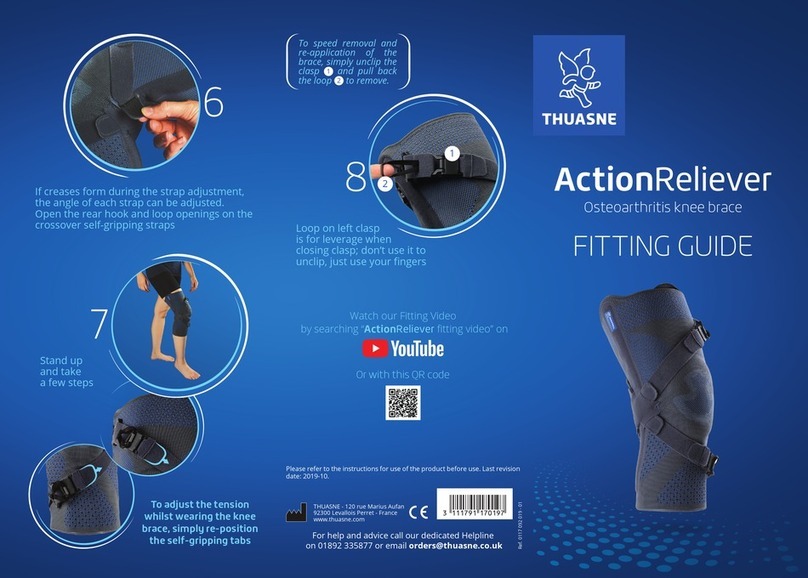
Thuasne
Thuasne ActionReliever Fittings guide

Tridien Medical
Tridien Medical BEDSIDE AIR CHAIR operating instructions
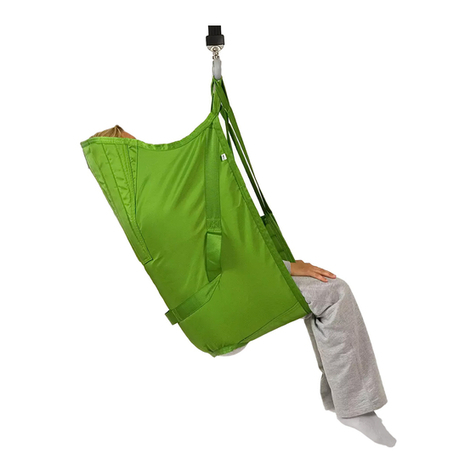
Liko
Liko Soft Original HighBack Sling Instruction guide
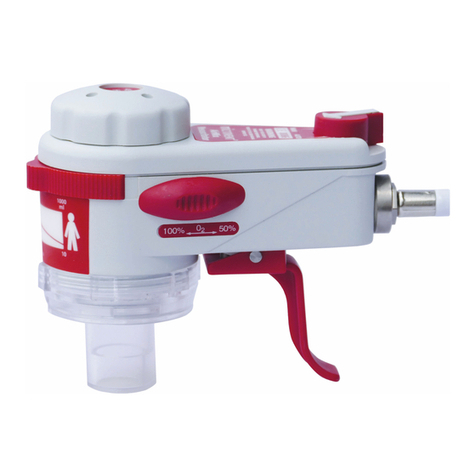
Meditech
Meditech microVENT World operating manual

NeoChord
NeoChord DS1000 Instructions for use
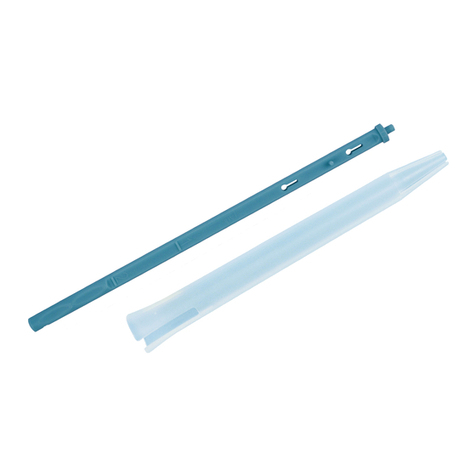
Fahl
Fahl LARYVOX INSERTER Instructions for use
